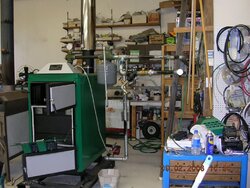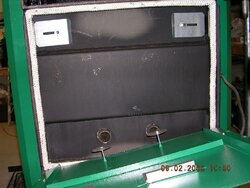I've been working on my EKO-60 ,with 2 five hundred gallon propan tanks for storage, since last April and today I fired the boiler up. It smoked a little at first then as it got hotter, burned cleaner though there was still a little smoke. My fan shutters are 1/2 open and the secondary air is 3-1/2 turns open. There is another air slider I guess under the front cover.Not sure if I need to add more air or try to find drier wood.
It took about 6 hours to heat the 1100 gallons of water from 40(f) to 135(f). The boiler output seems to run 175 to 180(f). I have a danfoss for return water protection and a UPS 26-99FC 3 speed circulator pump set on low speed.The hot water goes in the top of the tanks and the cool water is pulled from the bottom of the tanks. I could feel the stratification as the top warmed up first and there was definite line between hot on top and cool underneath. Most all the plumbing is 1-1/2" steel pipe. eventually I will pull hot water off the tanks to a heat exchanger, then from the heat exchanger to the fossil boiler. A super stor DHW tank is in the future as well......I'll try to post some pics tomorrow.
There seems to be a lot of tar in the upper chamber where the wood goes. I will try to find a few pallets and burn them as a test to see if maybe the wood I used today is too wet. I have the tanks housed in a 16x16 fram shed built beside my garage and house. After it burns for about a hour, I can open the top door and poke the wood with a poker, then close the door and turn the controller back on. The lower chamber has bluish/orange flames coming out but they only last for about 15 or 2o minutes, then when I look in the lower chamber, there is heat and a fair amount of smoke and I can't see the flames as all.......
I think I need to fine tune it and get some drier wood...
ALL in all I am pretty happy.!!
It took about 6 hours to heat the 1100 gallons of water from 40(f) to 135(f). The boiler output seems to run 175 to 180(f). I have a danfoss for return water protection and a UPS 26-99FC 3 speed circulator pump set on low speed.The hot water goes in the top of the tanks and the cool water is pulled from the bottom of the tanks. I could feel the stratification as the top warmed up first and there was definite line between hot on top and cool underneath. Most all the plumbing is 1-1/2" steel pipe. eventually I will pull hot water off the tanks to a heat exchanger, then from the heat exchanger to the fossil boiler. A super stor DHW tank is in the future as well......I'll try to post some pics tomorrow.
There seems to be a lot of tar in the upper chamber where the wood goes. I will try to find a few pallets and burn them as a test to see if maybe the wood I used today is too wet. I have the tanks housed in a 16x16 fram shed built beside my garage and house. After it burns for about a hour, I can open the top door and poke the wood with a poker, then close the door and turn the controller back on. The lower chamber has bluish/orange flames coming out but they only last for about 15 or 2o minutes, then when I look in the lower chamber, there is heat and a fair amount of smoke and I can't see the flames as all.......
I think I need to fine tune it and get some drier wood...
ALL in all I am pretty happy.!!



